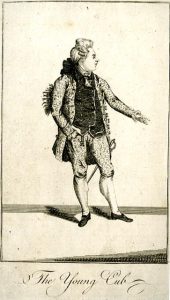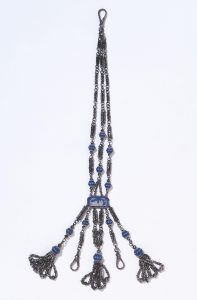
© The Trustees of the British Museum.

© The Victoria and Albert Museum Collection.
A macaroni is a longer version of a chatelaine. The difference lies in the fact that a macaroni does not have a belt or girdle suspensory hook. The macaroni chain was draped over a belt and had hooks at either end. One end generally suspended a medallion and five or so hooks for a watch and other necessaires. The other end usually suspended decorative tassels and a fausse montre. These chains could be quite elaborate with gemstones, pearls, and enamel embellishments. The macaroni was popular from Georgian times into the late Victorian era and was sometimes referred to as a hookless chatelaine.
Alternate Use: Macaronis, c.1770, were men who adopted an extreme fashion that involved tight-fitting clothes in bright, multi-colored hues. More importantly, they affected many sparkling elements to their sartorial splendor, including jeweled (or paste) buttons and shoe buckles. They often sported a “quizzing” glass as part of their unique ensemble.